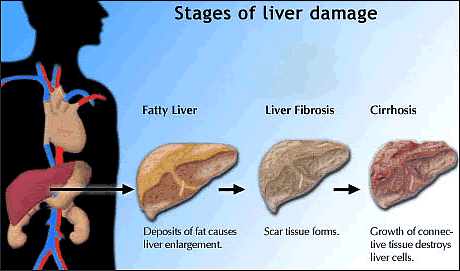Liver
Steatosis in People with HIV/HCV Coinfection
 |
 |
 |
 |
 |
 |
 |
| SUMMARY:
HIV positive people with chronic hepatitis C virus
(HCV) coinfected do not appear more likely to have
hepatic steatosis, or fat accumulation in liver cells,
than HIV positive individuals, according to a meta-analysis
reported in the July
2010 issue of Hepatology. The analysis
also saw no association with any class of antiretroviral
drugs. |
|
 |
 |
 |
 |
 |
 |
 |
By
Liz Highleyman
Mariana
Verdelho Machado from Hospital Santa Maria in Lisbon and colleagues
performed a meta-analysis of hepatic steatosis prevalence and
risk factors in HIV/HCV
coinfected patients.
Liver steatosis
is common in people with hepatitis C, reported in 40%-80% in
various studies, the authors noted as background. Past research
has linked steatosis to several risk factors including metabolic
syndrome and infection with HCV
genotype 3. Whether HIV coinfection or use of antiretroviral
therapy are also risk factors remains unclear, since prior
studies have produced conflicting data.

The
researchers identified eligible studies by doing a structured
keyword search (including coinfection, HCV, HIV, and steatosis)
in relevant databases including PubMed.
Results
 |
12
relevant studies were identified, with a total of 1989 HIV/HCV
coinfected participants. |
 |
20%
of participants were infected with HCV genotype 3, the type
most strongly linked to liver steatosis. |
 |
The
overall prevalence of hepatic steatosis was 50.8% (range
23% to 72%). |
 |
4
studies that also included a total of 1540 HIV negative
patients with hepatitis C alone did not show a significant
increase in steatosis risk for HIV/HCV coinfected patients
(odds ratio [OR] 1.61; P = 0.151). |
 |
Among
coinfected patients, hepatic steatosis was significantly
associated with higher body mass index (OR 1.13), diabetes
(OR 2.32), elevated ALT (OR 1.28), necro-inflammatory activity
(OR 1.72), and liver fibrosis (OR 1.67). |
 |
No
associations were found, however, between liver steatosis
and sex or other metabolic factors including metabolic syndrome
and abnormal blood lipid or glucose levels. |
 |
Hepatic
steatosis was also not associated with factors related to
HCV (viral load, genotype) or HIV (viral load, CD4 count,
use of antiretroviral therapy, ART drug class). |
Based
on these findings, the study authors concluded, "In coinfected
patients, hepatic steatosis does not seem to be more frequent
than in HCV monoinfected patients and is mostly associated with
metabolic factors, such as increased weight, diabetes mellitus,
and more severe liver disease."
"The fact that no associations with HCV factors were found
may be due to the small percentage of genotype 3-infected patients,"
they added.
They also saw no link with use of "d-drug" antiretroviral
agents -- including didanosine
(ddI, Videx) and stavudine
(d4T, Zerit) -- which have been reported to cause steatosis
and liver enlargement possibly related to mitochondrial toxicity.
Investigator affiliations: Departmento de Gastrenterologia,
Unidade de Nutricao e Metabolismo, Hospital Santa Maria, Faculdade
de Medicina de Lisboa, IMM, Lisboa, Portugal; Departamento de
Bioestatistica, Faculdade de Ciencias Medicas de Lisboa, Lisboa,
Portugal.
7/9/10
Reference
MV Machado, AG Oliveira, and H Cortez-Pinto. Hepatic steatosis
in patients coinfected with human immunodeficiency virus/hepatitis
C virus: a meta-analysis of the risk factors. Hepatology
52(1): 71-78 (Abstract).
July 2010.
